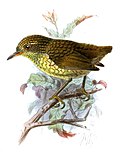| Tit-spinetails | |
|---|---|
 | |
| Plain-mantled tit-spinetail, Leptasthenura aegithaloides | |
| Scientific classification | |
| Kingdom: | Animalia |
| Phylum: | Chordata |
| Class: | Aves |
| Order: | Passeriformes |
| Family: | Furnariidae |
| Genus: | Leptasthenura Reichenbach, 1853 |
| Type species | |
| Synallaxis aegithaloides Plain-mantled tit-spinetail Kittlitz, 1830 | |
| Species | |
See text | |
Tit-spinetails are small passerine birds of the genus Leptasthenura, belonging to the ovenbird family Furnariidae. They are found in South America, particularly the southern and Andean parts of the continent. They are somewhat similar to birds of the tit family in their shape and feeding behaviour, hence the first part of their name. The "spinetail" part of their name refers to their long, pointed tail feathers. Tit-spinetails have short rounded wings, short pointed bills and are mainly brown in colour. Their nests are built in holes or the old nests of other birds.








